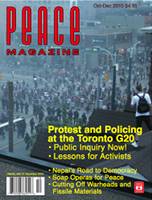
Peace Magazine Oct-Dec 2010, page 13. Some rights reserved.
Search for other articles by John Bacher here
The recent resumption of peace talks between India and Pakistan, after a three- year suspension because of the terrorist Mumbai bombings, could possibly lead to action on a proposal first put forward in 1994—the Siachen Peace Park.
Both parties to the conflict have recognized the need for confidence-building measures. One of the easiest ways to create such measures is through the peace park proposal, which would protect the environment of the world’s largest non-polar glacier (and the water supplies upon which 40 per cent of the world’s population depends). The park would also protect the habitat of a variety of endangered species, including the snow leopard, ibex, musk deer and the Himalayan brown bear.
Unlike most of the Kashmir conflict —which concern disputed lands with populations of varied faith traditions— the issues of the Siachen glacier dispute are more easily solved. This is because no one except soldiers involved in the dispute between India and Pakistan live here. Supporters of the peace park concept envisage a reduced number of soldiers on both sides, being given new roles as park rangers. Much of their work would involve the clean-up of toxic military debris, as well as protecting wildlife from poachers, and keeping an eye on visitors such as mountaineers.
Unlike the rest of Kashmir, the “line of control”, the de facto international border between India and Pakistan, is not defined by the UN-sponsored 1948 cease fire that ended the first war between India and Pakistan. Since the region was uninhabitated, this ambiguity did not cause friction until 1986. Then India occupied part of the region in response to rumors of a similar action from Pakistan. While there is now a ceasefire, some 3,500 soildiers died in the conflict, largely through diseases related to the harsh conditions of warfare at the top of the world. Each day India spends $2 million and Pakistan $1 million on troops occupying the disputed glacier. Discarded oil cans, ammunition cases, derelict vehicles, and human waste dumped in crevasses pollute the Nubra River.
The concept of the Siachen Peace Park was first put forward by the Indian environmentalist and mountain climber Aamir Ali in 1994.Mountaineers from India and Pakistan met in Switzerland to mobilize support for the Peace park. It has since gained considerable support, with Indian Prime Minister Manmohan Singh expressing hope that the region would become a “peace mountain.” In 2008 Indian and Pakistani glaciologists established a detailed plan for research partnerships that could facilitate the achievement of the peace park.
In April 28, 2009 representatives of India and Pakistan met in Norway to discuss the Siachen Peace Park. It was pointed out that in addition to glacial melt from global warming, the military competition between India and Pakistan was hastening the glaciers’ demise. Both sides routinely cut and melt glacial ice. Both sides also use chemicals to melt ice, making the Siachen the world’s fastest retreating glacier.
Better co-operation between India and Pakistan is one of the most urgent priorities for world peace. The realization of a peace mountain in one of the most vital areas of the earth’s ecology is an urgent priority.
John Bacher is an activist in St. Catharine’s, Ontario.

Peace Magazine Oct-Dec 2010, page 13. Some rights reserved.
Search for other articles by John Bacher here